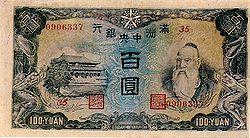Manchukuo yuan
The Manchukuo yuan was the money used in the Empire of Manchukuo, from June 1932 until August 1945.
The Manchukuo yuan would buy 24 grams of silver. The yuan was instead of the Chinese tael. The tael was common and was in use in Manchuria. A tael would buy about 40 grams of silver.
History
The Manchukuo yuan would buy 24 grams of silver in 1932. The price of silver changed and the yuan would not buy 24 grams of silver. To show that the yuan had value it was made equal to Japanese money. The Japanese money was called the yen. In 1940 the Manchukuo yuan was being used to measure Manchukuo exports and imports to America,[1] Germany and Japan.[2]
The paper money was in five values in 1932. Each piece of paper money is called a note. There was a one hundred yuan note, a ten yuan note, a five yuan note, a one yuan note and a small value note. A new 1000 yuan note was made in 1944.
The paper money or notes had pictures of Chinese emperors printed on them. The money was first made in Japan. Later they were made by the Bank in the Manchukuo capital of Hsinking (Hsinking is now called Changchun).
The Yuan was subdivided into 10 chiao, 100 fen or 1000 li. Coins were made that were worth 5 li and bigger values. The largest value coin was 10 fen.
In 1944 and 1945, Manchukuo made coins of red or brown cardboard.[3] These may be unique as to coining material, but they are not particularly scarce.
On January 1946 Manchukuo Yuan was replaced. The Chinese allowed people to swap 1 Manchukuo for a new type of money called a North-Eastern Yuan. In 1948 these new yuan could be swapped by a Gold Yuan. One Gold Yuan cost 150,000 North Eastern Yuans.[4]
Banknotes


Manchukuo Yuan Media
References
| Wikimedia Commons has media related to Lua error in Module:Commons_link at line 62: attempt to index field 'wikibase' (a nil value).. |
- ↑ Future of American Trade with Manchukuko, Roy H Akagi, 3 June 1940, accessed September 2009
- ↑ Germany and republican China, William C. Kirby 1984, p143, accessed September 2009
- ↑ "Standard Catalog of World Coins"
- ↑ Manchuko stamps, manchukuostamps.com, accessed September 2009













